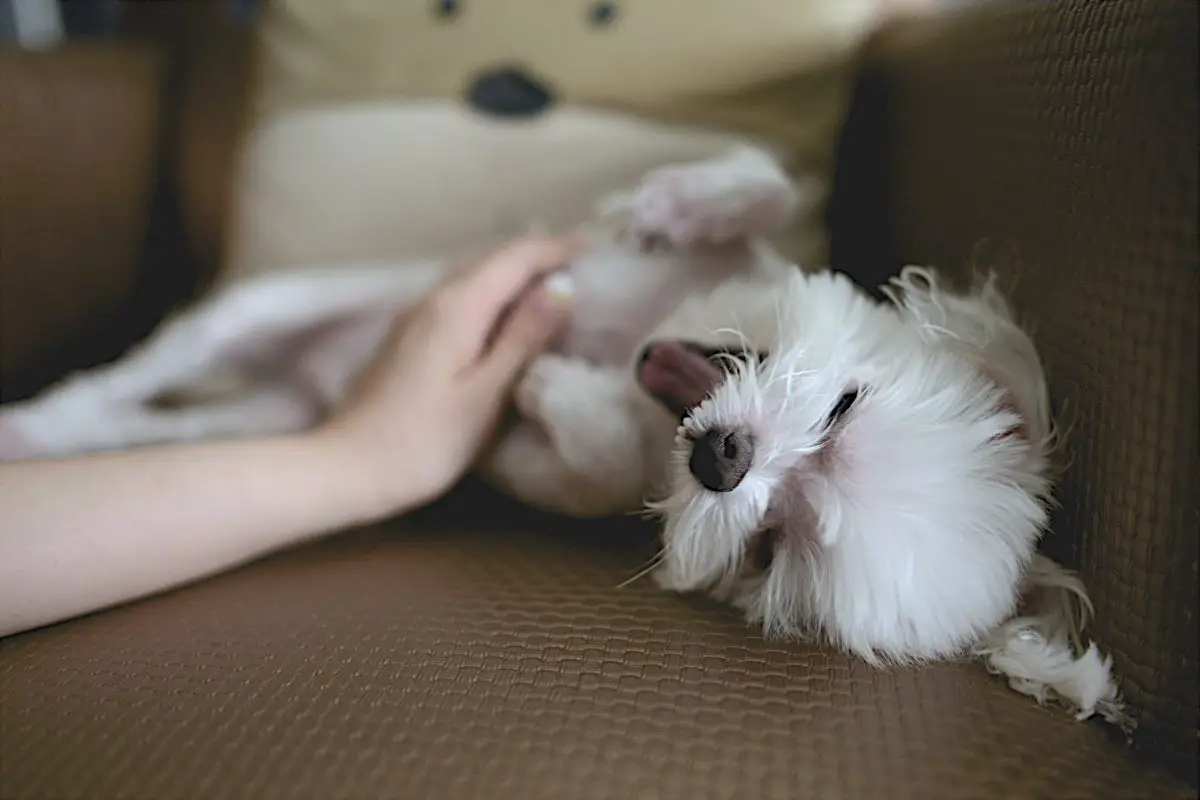Knowing the difference between allergies vs fleas can be one of the hardest things for a pet owner to distinguish.
If your pet appears to be itching all day, the first thing we think of is fleas. However, what happens when you have done that dreaded search for fleas and find nothing? Well, we start to question what else may be causing their itching.
Knowing the difference between whether your pet has an allergy or has fleas can make a world of difference when it comes to trying to cure the problem.
Allergies may be a lot more serious, or they may be curable by simply cutting out the source of the problem. Fleas are extremely common and easy to treat, but also something you want to get under control as soon as possible.
In this article, I am going to summarize some of the key ways that you can figure out what it is that is causing your pet such excessive scratching. Hopefully by the time you reach the end you will have an idea of how to help them return to normality!

Signs of Fleas
The first option that we should remove from the equation when it comes to scratching, is fleas.
Fleas are a type of parasite that survive by feeding off the blood of our pets. Sounds pretty gruesome right? Well, try not to worry too much. If it does turn out that your pets have fleas then there are a number of easy ways to get rid of them.
The fur on dogs and cats, and most animals, make a perfect nest for fleas to get warm and comfy and to burrow into the skin, similar to ticks.
The fleas themselves do not cause the itching, but flea bites do. Because of this, it is important to know how to identify flea bites if you are not able to spot any fleas.
Common Signs of Fleas
- Excessive scratching
- Loss of fur
- Biting out chunks of fur
- Scabs
- Red patching on the skin
- Skin infections
- Ear infections
- Small bumps around the body or neck areas
- Flea dirt (more on this later)
Any of the symptoms are a sign that it is time to do a thorough inspection of your pet. Typical areas for fleas to set up camp are under armpits, in or behind ears, the tail, groin area, and the back of the head or the neck. This is because these are the warmest places for fleas to live.
If you do detect any fleas on your pet, you need to remove them as soon as you can to prevent them breeding and spreading.
You can use a number of treatments. Some will be available from your vet, but you can buy flea shampoo from any pet store. Ensure you follow the instructions correctly for the most effective results.
There are also some cheaper and more accessible methods, such as Avon Skin So Soft.
Most flea control will provide support for around 30 to 90 days. It is important that if you have a cat, you stick to cat treatment, and for dogs you stick to dog treatment.
Animals may also have allergies towards certain shampoos and so it is important to keep this in mind when choosing your treatment. If you do notice continued itching from the treatment, you should speak to your vet.
Pets can also create allergic reactions to flea bites themselves which can cause intense itching for a few weeks. Again, if you suspect an allergy occurring from not only the shampoo, but from flea bites, this is something you should contact your vet about.
What Is Flea Dirt?
One of the main signs of fleas and a major cause for itching, is flea dirt. Flea dirt is tiny black dots made up of flea droppings (both their blood and feces), that can embed itself in your pet’s fur. This can be identified by using a flea comb and sifting through your pet’s fur. It will look like tiny black residue.
You can also give your pet a bath. If you notice the water turning a red color from the dried blood, this is a sign of flea dirt.
Sometimes flea dirt is easier to identify than fleas themself, but one is a clear indication of the other.
To tackle flea dirt, begin by washing your pet in the bath. Combing and brushing your pet on a daily basis will also help to prevent this. When combing and brushing, it is important to then thoroughly vacuum afterwards. The eggs and fleas may drop off and later reattach themselves to your pet.
Even once your pets have been cleared of fleas, vacuuming and cleaning is an important step for future prevention. They may continue to live on your furniture and carpets for longer.
Fleas peak during spring and summer, but they can continue to live in your garden and home for weeks, waiting to build a home back on your pets.
Fleas can also live on humans and their clothing. Whilst humans suffering from fleas is not very common, your clothing can be a great place for them to ride and be carried into your home. It only takes a couple of fleas to create a full infestation. Cleaning not only your home, but your clothing is important.
The best treatment for fleas is prevention. So following these simple steps can help stop your animals from ever catching fleas.
Dog and Pet Allergies
If you have followed all of the steps to preventing and finding fleas, and there still seems to be no indication of fleas but ongoing itching from your pet, it is time to consider a possible allergy.
Allergies are caused by a reaction to a foreign substance that has made its way into your pet’s immune system. Whilst this sounds very serious, a lot of the time it can be a simple fix. Your pet will react negatively to something it is not used to, and this will cause a reaction.
Common Signs of a Pet Allergy
- Excessive scratching
- Excessive licking
- Red or scabbed skin
- Itchy ears
- Runny eyes
- Sneezing and coughing
- Vomiting
- Diarrhea
- Paw chewing
Any of the above can indicate that your pet has an allergy. As you can see, a lot of them overlap with the symptoms of fleas. So it is important to consider both when assessing your pet.
Allergies are usually caused by an environmental factor, fleas, or food allergies.
Environmental Allergies
Environmental allergies can be caused by both indoor and outdoor environments. Similar to human allergies, it can be caused by regular outdoor occurrences such as pollens, grass, trees or fleas. These can be difficult because many outdoor causes are things that we have no control over.

If you do find that your pet is suffering from an outdoor allergy, such as pollen or grass, you can speak to your vet. They will help find a medication or treatment that will prevent your pet from getting ill or reacting so harshly to the cause.
Indoor causes are slightly different, and are usually impacts that we have more control over. Indoor allergies are most commonly caused by cigarette smoke, dust mites, cleaning chemicals, wool, mold, cotton, perfumes, rubber and plastic materials.
Once you have found the source, it is a lot easier to remove this or to change your product so that it does not impact your pet. Similarly, with those that cannot be helped, you should speak to your vet about a possible treatment.
Flea Allergies
As mentioned, dogs may also have an allergy towards fleas. This is known as flea allergy dermatitis. This is caused when your pet has an allergic reaction to flea saliva after the flea bites the animal.
This will cause excessive itching all over the animal, but is most commonly found on the base of the tail.
Further signs are other symptoms of fleas, such as scabbing, flea dirt and red skin. You can follow the steps above to help prevent fleas. But if it has reached the point of scabbing and sore skin, you should contact your vet for treatment of this.
Food Allergies
Finally, pets can develop allergies to the food they are given. Pets eat all kinds of things when they are exploring outside. A lot of the time this is out of our control.
However, what we choose to feed them in the house can really help prevent any allergies forming.
Despite what we may expect, the most common pet allergies are caused by foods like pork, chicken, corn and wheat.

If you do recognise your pet is developing an allergy, it is best to alter their food and see if this helps. You can also speak to your vet and they can help to suggest some alternatives.
Whilst it is easier to identify human allergies, this is not yet the same for pets. The best method of figuring out allergies in a pet is by trial and error. If you slowly eliminate certain food types, you will eventually be able to figure it out.
You will need to allow a few weeks for this and to give time for allergic reactions to disappear before knowing what exactly is the cause of your pet’s allergy. Again, your vet will be able to suggest specifics that may help to speed up the process without having your pet continue to eat something it is allergic to for too long.
Does my dog have allergies or fleas? – Final Thoughts
So, distinguishing between allergies and fleas can be tricky due to a number of overlapping symptoms. Fleas may actually be the cause of the allergy which is one of the trickier situations to deal with.
Always begin by inspecting your pet for fleas. Help to prevent this all year round with cleaning and washing both your pet. Also clean the house and your clothing.
If your dog does have fleas, there are a number of easy ways to eliminate them.
As for allergies, there are a number of causes that your pet may have an allergy. In most cases, you should speak to your vet to find out the easiest and most efficient way of identifying the allergy.
If you have tried all of the above and still have no answer as to why your pet is itching, you should turn to professional support.
FAQs
Dog allergies can be caused by may things but usually it is caused by environmental factors, fleas, or something they have eaten.

